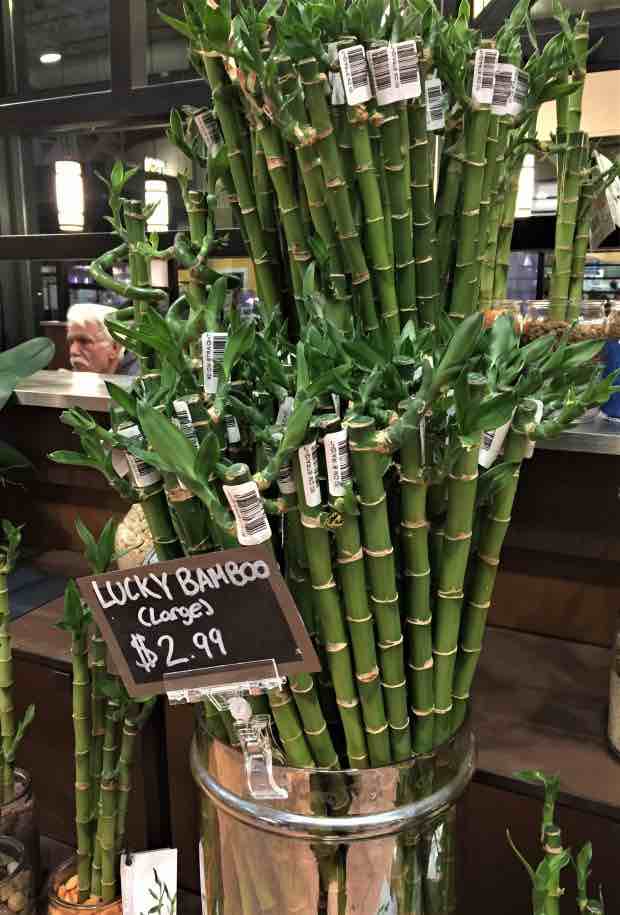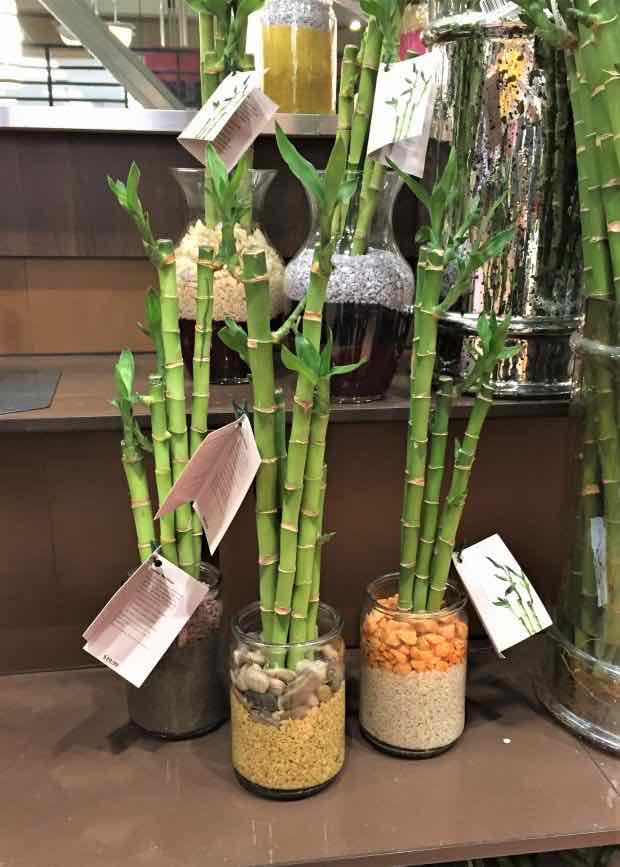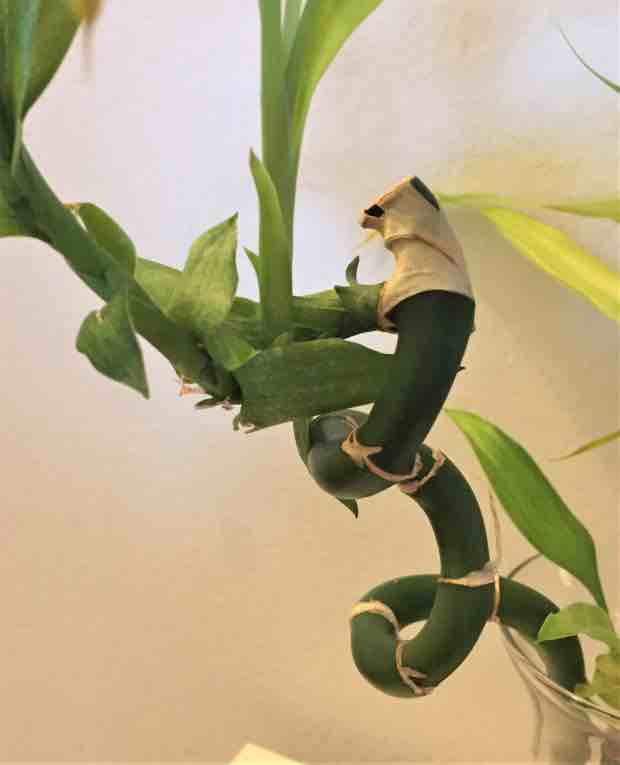The Ultimate Lucky Bamboo Care Guide
The lucky bamboo, with its twisty shape and sculptural design, is a plant that’s hard to miss and resist! These guys make a great addition to any household. And, best of all, lucky bamboo care can be a simple undertaking.
Although the look is similar to, and the name says “bamboo” the lucky bamboo plant is actually not bamboo at all. (So, in other words, don’t feed this guy to any pandas!)
In fact, the lucky bamboo belongs to the Dracaena genus and they’re scientifically known as either Dracaena sanderiana or braunii.
In warm, southern climates, where temperatures don’t drop below 50 degrees F, lucky bamboo can be grown outside. However, they will not survive outdoors in colder climes. That’s why, in North America, you’ll find lucky bamboo is a popular indoor plant for both homes and offices.
This versatile plant can be grown either hydroponically (in water), or in soil. In stores, you’ll find them sold in either medium. Not only that, you can usually purchase lucky bamboo in bundles of three or more, or as individual stalks.
However you’ve picked your lucky bamboo plant though, know you’ve made a good choice. They’re a great plant for a novice or a pro, and with this guide to lucky bamboo care, you’ll have no problem keeping your plant happy and healthy.
GUIDE TO LUCKY BAMBOO CARE:
Although native to Africa, for thousands of years, the lucky bamboo has been associated with Asian culture and is purported to bring good luck and good feng shui.
Not only that, lucky bamboo plants make popular gifts, symbolizing your wish for the receiver to have good fortune, health, and overall prosperity.
Take note, though, that the different numbers of stalks have different meanings. And never gift four stalks, which can symbolize death and negative energy.
But, as you’ll see in this guide, it’s the lucky bamboo’s hardiness and easy care that make this plant fortunate for us.
WATER & HUMIDITY
Water And Hydroponics:
When growing lucky bamboo hydroponically, it’s very important you give your plant fresh water every 7 – 10 days.
But it’s not just the frequency of the water that’s important. The type of water you’re using can also play a strong role in lucky bamboo care.
This plant can be sensitive to chlorine and other chemicals in your tap water. So, it’s best to use filtered or distilled water. If neither are available to you, you can fill a container with tap water, then let it sit out for 24 hours to allow the chlorine to evaporate.
Personally, I use tap water that has had time to settle. However, I’ve recently decided to switch my lucky bamboo to filtered water because I’m not super happy with its leaf quality.
When filling your lucky bamboo container, make sure the water is high enough to cover all the roots. Beyond that, there’s really no need to go much higher, as long as you’re not concerned the water will evaporate and expose the roots. In fact, the higher up the stem the water covers, the higher the roots will form.
Lastly, if growing in water, you might want to keep the roots covered with a layer of pebbles to provide stability to the plant.
Water And Soil:
When growing your lucky bamboo in soil, it’s important the container has good drainage. Although lucky bamboo prefers moist soil, it won’t like soggy soil. Adding too much water can negatively impact the plant’s growth. A good rule of thumb is to water the soil when the top inch is dry.
Humidity
As for humidity, there’s really nothing special you need to do here. A lucky bamboo plant will take a moderate humidity level.

LIGHT & TEMPERATURE
Light:
Lucky bamboo prefers bright, indirect light. However, it will tolerate lower light. Avoid direct, harsh sunlight as this can burn the leaves.
If you find the green fading on your plant, this could be a sign it’s not getting enough light.
Fun fact – A lucky bamboo does not naturally grow in those twisty shapes. Professional growers manipulate the plant’s growth using light. It’s possible for you to do this yourself, but it can be labour intensive. If you are interested in learning more, take a look at this article from Hunker on how to shape lucky bamboo.
Temperature:
Lucky bamboo prefers temperatures on the warmer side – usually between 65 – 90 degrees F.
And, they don’t enjoy drafts.
I learned this the hard way. Last winter, I had my plant sitting above a window. Unbeknownst to me, the window was not closed properly and so a cold draft was often blowing onto my plant. I noticed him struggling and discovered the problem. Thankfully, being such a hardy fellow, he survived.
Soil:
When it comes to lucky bamboo soil, think rich and well-draining. As I said above, this plant likes it moist but he doesn’t want his feet sitting in a puddle.
You want to aim for soil with good organic material, but one that’s also airy and won’t compact easily. In other words, your lucky bamboo soil should both retain moisture and drain well.
Tip: Although it can be grown hydroponically, planting a lucky bamboo in soil will extend its life.
MAINTENANCE
Hydroponic Care:
When growing hydroponically, one of the most important tasks with lucky bamboo care is keeping the water and container clean.
The water should be changed every 7 – 10 days.
As for cleaning the container, the frequency depends on whether or not you’re using a clear container. With clear containers, sunlight can penetrate the glass which, in turn, can encourage algae growth.
I can’t stress enough how crucial it is to periodically give your container a good wash to prevent build-up.
And while you have your plant out of its container, take the time to inspect the roots. Healthy roots should be red or orange.
Fertilizing:
Lucky bamboo needs minimal fertilizer. If you are going to fertilize, use just one drop of liquid fertilizer every 1 – 2 months during the growing season.
Trimming Your Lucky Bamboo:
This plant has segmented stalks that end in clusters of long, narrow leaves. Over time, the stalk can lengthen and your plant may become top-heavy.
This means pruning can be an important part of lucky bamboo care if you want to keep your plant bushier or at a certain height.
Fun Fact – lucky bamboo leaves can grow up to one inch per month.
To keep your lucky bamboo under control, and looking full and healthy, look to the offshoots.
You’ll want to start with any offshoots that are long or unsightly. Cut the offshoot an inch or two from the main stem. New shoots will then emerge on the sides of the cut stem, resulting in a bushier plant.
Alternately, you can trim the new shoots right at the base, where the shoot meets the stem. When trimmed flush with the stalk, it’s less likely new shoots will grow from the spot. (These cuttings can be propagated, so make sure to keep them if you’d like to add to your lucky bamboo collection.)
Cuts should be made just above the node, which is the ring-like formation around the stem.
One thing to be aware of, if you cut the stalk of the plant, the stalk will no longer grow in height. New side offshoots may surpass the height of the cut stalk, but the stalk itself will not grow any taller. For this reason, you want to plan out ahead of time where you will be trimming your lucky bamboo, so the plant retains the look you want.
It’s also important you use a clean, sharp instrument and that the cut is flat, not all jagged. This will help keep the risk of infection down, especially if you’ve decided to cut the main stem.
When To Repot:
Whether you’re growing hydroponically or in soil, you’ll want to repot once the container becomes too small for the roots.
In soil, you’re generally looking at about once every two years. In water, you should be able to eyeball the roots in comparison to the container size.

LUCKY BAMBOO PROPAGATION
To propagate your lucky bamboo, examine your plant and pick a healthy shoot that has at least one leaf joint. As I said, you can do this in conjunction with giving your lucky bamboo a haircut.
Clip the offshoot at its base, where it joins the parent stalk. Remove the lower leaves to expose the growth nodes (the place where the leaves formed). Then place the cutting into a container with enough distilled or filtered water to cover the bottom of the cutting. Remember, the higher the water level, the higher roots will form.
Keep the water clean and fresh, and in about 30 days new roots should form.
At this point, you can either add rocks to stabilize the plant and roots, if growing hydroponically. Or, you can plant your new bamboo in soil.
PESTS AND PROBLEMS
Pests:
Lucky bamboo can be susceptible to common houseplant pests, such as mealybugs or spider mites. If you notice little critters hanging around, treat your plant immediately. You can give him a good bath and try to manually remove as many pests as possible. Afterward, follow up with insecticidal soap or, in the case of mealybugs, rubbing alcohol.
Disease & Other Problems:
Oftentimes, the biggest issue with lucky bamboo care surrounds water quality. If you allow your water to become stale and polluted, you’re going to have issues with your lucky bamboo plant.
Poor water quality can encourage fungus and bacteria. If your stems are turning mushy or black, this could be a sign of rot. In this case, separate the damaged stem from the other stems, clean the container and rocks and fill the container back up with fresh, filtered, or distilled water.
Browning Leaves On Lucky Bamboo:
Brown leaves can be a sign of:
- The air is too dry
- The water is polluted
- There is too much chlorine or other chemicals in the water
If your lucky bamboo leaves are browning, remove the affected leaves with a clean, sharp instrument. Clean the container and change the water, using filtered or distilled water.
For plants in soil, give the soil a good flush by pouring water into the soil until it runs steadily out the bottom. Then start using only filtered or distilled water on your plant.
If you suspect the air is too dry, you can try to increase the humidity by moving your plant away from any vents and to a spot that has at least moderate humidity. You can also group it with other plants to help raise the humidity level. Lastly, you can put a small humidifier or mister by your plant.
Yellowing Leaves On Lucky Bamboo:
Yellow leaves on a lucky bamboo plant can indicate:
- Too much sunlight
- Too much fertilizer
- Too hot or cold
If your plant is getting too much direct sunlight, then you’ll need to move it to a lower light spot. Remember, a lucky bamboo plant likes bright light, but not direct sunlight.
Same with temperature extremes. If the plant is experiencing this in its current location (as mine did sitting near the drafty window), move the plant to a more suitable spot.
If you’ve over-fertilized, then hold off on fertilizing.

TOXICITY
Lucky Bamboo is toxic to cats and dogs and can cause weakness, vomiting, or other abdominal issues. However, lucky bamboo is generally considered non-toxic to humans.
CONCLUSION
As you can see, lucky bamboo care is not difficult. A medium to bright spot (no direct sun) and water that is fresh and clear of chemicals, and you’ll keep this unique plant around for a long time.







Leave a Reply
You must be logged in to post a comment.